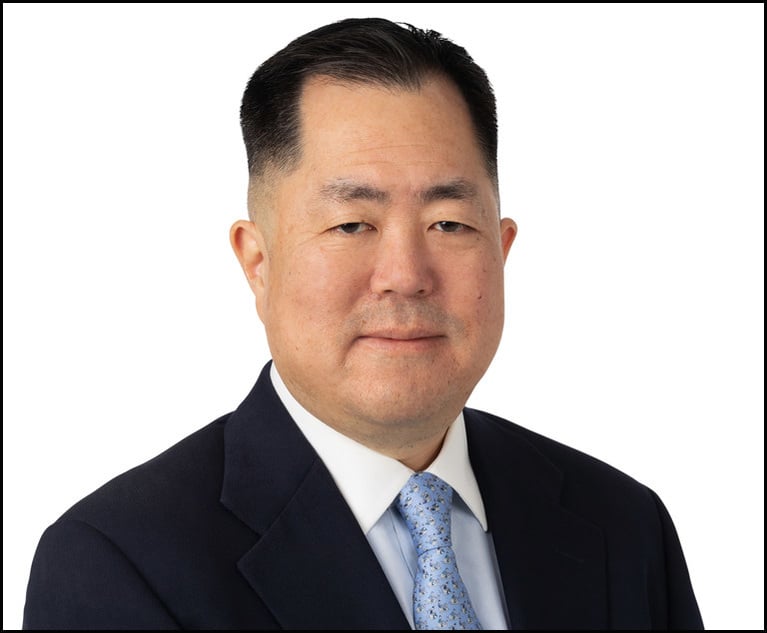 Tony Malkani, Rutan & Tucker.
Tony Malkani, Rutan & Tucker.
The following is a selection from The Mid-Market Report's Q&A series to help readers get to know midsize law firms around the country, and how they are innovating in an ever-changing legal landscape. More information about subscribing to the Mid-Market Report is available here.
Firm Name: Rutan & Tucker
Firm Leader: Tony Malkani, Executive Director
Head Count: 150 attorneys
Locations: Orange County (Costa Mesa), Palo Alto and San Francisco (opening in May 2019)
Practice Areas: Full-service
Governance structure and compensation model: The firm is managed by an executive committee of three partners, led by a managing partner. The executive committee oversees firm strategy and governance and the executive director, who is an ex-officio member of the executive committee, manages the firm's operations. Each practice group has a partner in the role of department or section head. Compensation is determined by a compensation committee which also includes the three members of the executive committee. The compensation model is largely formulaic and is transparent to the entire partnership.
Do you offer alternative fee arrangements? Yes. Alternative fee arrangements are part and parcel of today's legal service environment.
The following answers were provided by Malkani, and edited lightly for style.
What do you view as the two biggest opportunities for your firm, and what are the two biggest threats?
The burgeoning Orange County economy over the past couple of years and growth of new business in the county has created and maintained demand for our legal services. Our reputation as the oldest and largest full-service Orange County law firm with quality lawyers will always attract clients. The threat of a change in market conditions keeps us efficient and cost-conscious. In recent years, we have been faced with the reality of occasionally losing young lawyers to larger markets such as San Francisco and Los Angeles. To alleviate this, we are in the process of opening a San Francisco office.
The legal market is so competitive now—what trends do you see, and has anything, including alternative service providers, altered your approach? Is your chief competition other mid-market firms, or is your firm competing against big firms for the same work?
Trends in today's legal market include a heightened focus on cybersecurity and a move to artificial intelligence tools. While we maintain a forward-looking focus and continue to invest in technology, we have always maintained a conservative business model and have been able to provide our clients with quality service which matches that of global firms, but at lower rates. These efficiencies have served us well over time and enable us to maintain a competitive edge. We have not seen an impact on our business by alternative service providers. We compete with both middle-market as well as national and global firms.
There is much debate around how law firms can foster the next generation of legal talent. What advantages and disadvantages do midsize firms have in attracting and retaining young lawyers, particularly millennials?
Despite the growth of our firm over time, we have been able to maintain our collegial culture, which makes us attractive to the next generation of legal talent. Our size enables us to be adaptable and nimble and the resulting flexibility of operations helps us attract and retain young lawyers. In our entrepreneurial business model, young associates are assigned challenging work and are not pigeonholed into performing repetitive tasks. We work hard at recruiting and maintaining a diverse work force. The only disadvantage of being a regional California firm is not having a large international footprint.
Does your firm employ any nonlawyer professionals in high-level positions (e.g. COO, business development officer, chief strategy officer, etc.)? If so, why is it advantageous to have a nonlawyer in that role? If not, have you considered hiring any?
I serve as the firm's executive director/COO and bring years of financial and operational experience to the position, having previously worked with both global and midsize firms. I serve as an ex-officio member of the executive committee and as a nonlawyer, am able to dedicate myself full-time to firm management. Other non-lawyer professional positions include a director of finance, a director of technology and a litigation support director. The three partners on the executive committee are practicing lawyers, and enjoy the benefit of being able to shape long-term firm strategy with the support of a professional operations team.
What would you say is the most innovative thing your firm has done recently, whether it be technology advancements, internal operations, how you work with clients, etc.?
We have implemented a few innovative programs in recent times. The firm has made huge technological strides in the cybersecurity arena over the past few years. We are actively looking at artificial intelligence tools for research and litigation support. We created the internal full-time position of client relations partner, which has led to more synergistic alliances with our clients.
Does your firm have a succession plan in place? If so, what challenges do you face in trying to execute that plan? If you don't currently have a plan, is it an issue your firm is thinking about?
As our long-term partners retire, we have successfully shifted the reigns of management to the next generation. Our current managing partner, Bill Meehan, is one of the youngest managing partners in the history of the firm. We recently added the position of “assistant section/department head” to each practice, which naturally creates a pool of younger lawyers who can be provided an opportunity to serve in future senior management roles at the firm. We also require retiring partners to work on transitioning their clients to others at the firm during their last few years in practice.
This content has been archived. It is available through our partners, LexisNexis® and Bloomberg Law.
To view this content, please continue to their sites.
Not a Lexis Subscriber?
Subscribe Now
Not a Bloomberg Law Subscriber?
Subscribe Now
NOT FOR REPRINT
© 2025 ALM Global, LLC, All Rights Reserved. Request academic re-use from www.copyright.com. All other uses, submit a request to [email protected]. For more information visit Asset & Logo Licensing.
You Might Like
View All
Husch Blackwell Hires Former Adobe Counsel to Oversee AI Advisory Offering
3 minute read
Legal Tech's Predictions for Artificial Intelligence in 2025

DLA Piper Adds Former Verizon GC Amid In-House Hiring Spree

Trending Stories
- 1NY Top Court to Decide Whether County Governments Owe Special Duty to Foster Care Placements
- 2Tesla, Musk Appeal Chancery Compensation Case to Delaware Supreme Court
- 3Some New Twists and Old Tricks for an Ethical New Year
- 4TikTok Hit With California Class Action for Allegedly Mining Children's Data Without Parental Consent
- 5New York Latest to Adopt NextGen Bar Exam
Who Got The Work
Michael G. Bongiorno, Andrew Scott Dulberg and Elizabeth E. Driscoll from Wilmer Cutler Pickering Hale and Dorr have stepped in to represent Symbotic Inc., an A.I.-enabled technology platform that focuses on increasing supply chain efficiency, and other defendants in a pending shareholder derivative lawsuit. The case, filed Oct. 2 in Massachusetts District Court by the Brown Law Firm on behalf of Stephen Austen, accuses certain officers and directors of misleading investors in regard to Symbotic's potential for margin growth by failing to disclose that the company was not equipped to timely deploy its systems or manage expenses through project delays. The case, assigned to U.S. District Judge Nathaniel M. Gorton, is 1:24-cv-12522, Austen v. Cohen et al.
Who Got The Work
Edmund Polubinski and Marie Killmond of Davis Polk & Wardwell have entered appearances for data platform software development company MongoDB and other defendants in a pending shareholder derivative lawsuit. The action, filed Oct. 7 in New York Southern District Court by the Brown Law Firm, accuses the company's directors and/or officers of falsely expressing confidence in the company’s restructuring of its sales incentive plan and downplaying the severity of decreases in its upfront commitments. The case is 1:24-cv-07594, Roy v. Ittycheria et al.
Who Got The Work
Amy O. Bruchs and Kurt F. Ellison of Michael Best & Friedrich have entered appearances for Epic Systems Corp. in a pending employment discrimination lawsuit. The suit was filed Sept. 7 in Wisconsin Western District Court by Levine Eisberner LLC and Siri & Glimstad on behalf of a project manager who claims that he was wrongfully terminated after applying for a religious exemption to the defendant's COVID-19 vaccine mandate. The case, assigned to U.S. Magistrate Judge Anita Marie Boor, is 3:24-cv-00630, Secker, Nathan v. Epic Systems Corporation.
Who Got The Work
David X. Sullivan, Thomas J. Finn and Gregory A. Hall from McCarter & English have entered appearances for Sunrun Installation Services in a pending civil rights lawsuit. The complaint was filed Sept. 4 in Connecticut District Court by attorney Robert M. Berke on behalf of former employee George Edward Steins, who was arrested and charged with employing an unregistered home improvement salesperson. The complaint alleges that had Sunrun informed the Connecticut Department of Consumer Protection that the plaintiff's employment had ended in 2017 and that he no longer held Sunrun's home improvement contractor license, he would not have been hit with charges, which were dismissed in May 2024. The case, assigned to U.S. District Judge Jeffrey A. Meyer, is 3:24-cv-01423, Steins v. Sunrun, Inc. et al.
Who Got The Work
Greenberg Traurig shareholder Joshua L. Raskin has entered an appearance for boohoo.com UK Ltd. in a pending patent infringement lawsuit. The suit, filed Sept. 3 in Texas Eastern District Court by Rozier Hardt McDonough on behalf of Alto Dynamics, asserts five patents related to an online shopping platform. The case, assigned to U.S. District Judge Rodney Gilstrap, is 2:24-cv-00719, Alto Dynamics, LLC v. boohoo.com UK Limited.
Featured Firms
Law Offices of Gary Martin Hays & Associates, P.C.
(470) 294-1674
Law Offices of Mark E. Salomone
(857) 444-6468
Smith & Hassler
(713) 739-1250






